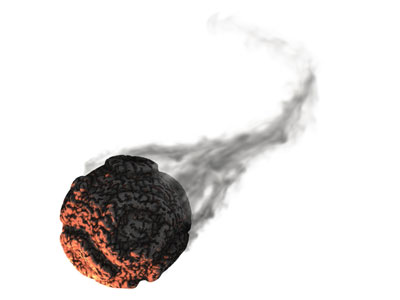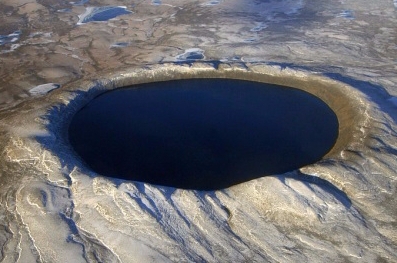What would happen if a meteor hit Earth?

Artistic depiction of a meteor (ZargonDesign - iStock)

Artistic depiction of a meteor (ZargonDesign - iStock)
How does this align with my curriculum?
Explore the effects of asteroid impacts in this hands on activity.
What You Need
- Shallow pan (or sandbox)
- Flour or fine sand
- Marbles or marble-sized stones
Safety First!
When experimenting with flour or sand, take care not to get particles in your eyes. Adult supervision recommended.
What To Do
- Put some flour or fine sand in the pan, covering the bottom with at least 3 cm. Alternatively, you can also go out into a nearby sand box.
- Gently drop or throw the “meteors” (marbles or stones) into the flour or sand, starting at about 50 cm above the pan.
- Vary the size of the meteor, the speed of the meteor and the angle of impact of the meteor. What are the results?
Discovery
Have you ever seen “shooting stars”? They aren’t stars at all – they’re actually small chunks of dust, rock, iron or ice that fall towards Earth. These are called meteors.
Sometimes, a meteor is big enough that it doesn’t completely get vapourized on its trip through the atmosphere. This only happens rarely and when a meteor does make it to the ground, it is called a meteorite. Once in a while, a meteorite is large enough to make a crater, or bowl-shaped hole, in the Earth that can be meters or kilometres wide.
When meteors make it through the atmosphere and land on the surface of the Earth as meteorites, these special rocks can teach scientists a lot about space. Many scientists study meteorites to learn about what kinds of matter can be found in outer space. Some scientists have even started looking for proof of alien life on these meteorites!
The impact of meteorites on the Earth’s surface can create unique landforms and affect the geology (landforms, rocks and minerals) of the region where the impact took place. The Sudbury Basin is a unique geological region of Ontario that has rock formations and mineral deposits created as a result of a meteor impact in the Paleoproterozoic era - about 1.8 billion years ago! This region of Canada is famous for its mining industry.
- Watch the night sky on a clear night in a dark location and try to spot shooting stars.
To learn more about this topic check out these Let's Talk Science resources:
- Impact Craters (Backgrounders) - Learn about how craters are formed and about some of Canada's impact craters.
- Where can we find asteroids and comets? (Backgrounders) - This backgrounder explains the difference between planets, dwarf planets and small solar system bodies.
- Could we stop an asteroid? (STEM in Context) - If an asteroid were to hit the Earth it could be disastrous. Here are some ways we could protect ourselves.
- Dealing with Asteroids and Other Space Hazards (STEM in Context) - Find out how asteroids, space debris, and cosmic radiation can be dangerous, and how to monitor them and protect ourselves from these space hazards.
- To find videos on this topic go to the Let's Talk Science STEM Channel and search by the word meteorite.
What’s happening?
Have you ever seen “shooting stars”? They aren’t stars at all – they’re actually small chunks of dust, rock, iron or ice that fall towards Earth. These are called meteors.
Sometimes, a meteor is big enough that it doesn’t completely get vapourized on its trip through the atmosphere. This only happens rarely and when a meteor does make it to the ground, it is called a meteorite. Once in a while, a meteorite is large enough to make a crater, or bowl-shaped hole, in the Earth that can be meters or kilometres wide.
Why does it matter?
When meteors make it through the atmosphere and land on the surface of the Earth as meteorites, these special rocks can teach scientists a lot about space. Many scientists study meteorites to learn about what kinds of matter can be found in outer space. Some scientists have even started looking for proof of alien life on these meteorites!
The impact of meteorites on the Earth’s surface can create unique landforms and affect the geology (landforms, rocks and minerals) of the region where the impact took place. The Sudbury Basin is a unique geological region of Ontario that has rock formations and mineral deposits created as a result of a meteor impact in the Paleoproterozoic era - about 1.8 billion years ago! This region of Canada is famous for its mining industry.
Investigate further
- Watch the night sky on a clear night in a dark location and try to spot shooting stars.
To learn more about this topic check out these Let's Talk Science resources:
- Impact Craters (Backgrounders) - Learn about how craters are formed and about some of Canada's impact craters.
- Where can we find asteroids and comets? (Backgrounders) - This backgrounder explains the difference between planets, dwarf planets and small solar system bodies.
- Could we stop an asteroid? (STEM in Context) - If an asteroid were to hit the Earth it could be disastrous. Here are some ways we could protect ourselves.
- Dealing with Asteroids and Other Space Hazards (STEM in Context) - Find out how asteroids, space debris, and cosmic radiation can be dangerous, and how to monitor them and protect ourselves from these space hazards.
- To find videos on this topic go to the Let's Talk Science STEM Channel and search by the word meteorite.
